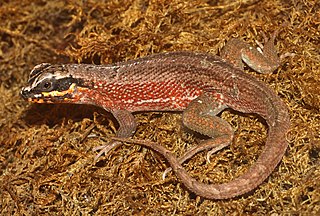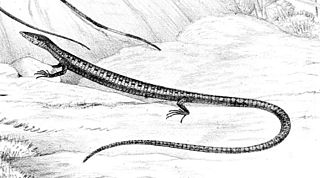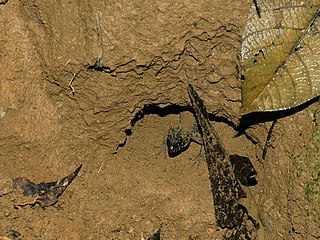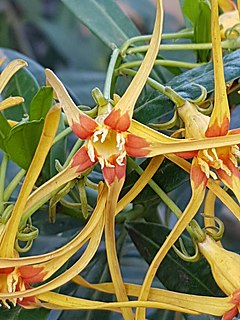
Gymnophthalmidae is a family of lizards with at least 250 species, sometimes known commonly as spectacled lizards or microteiids. They are called "spectacled" because of their transparent lower eyelids, which allow them to still see with closed eyes. As in most lizards, except geckos, these eyelids are movable. The Alopoglossidae have been recently moved from this family.

Gymnophthalmus is genus of lizards in the family Gymnophthalmidae. The genus is native to Mexico, Central America, and the northern part of South America. Eight species are recognized as being valid.

Micrablepharus is a small genus of lizards endemic to South America.

Iguania is an infraorder of squamate reptiles that includes iguanas, chameleons, agamids, and New World lizards like anoles and phrynosomatids. Using morphological features as a guide to evolutionary relationships, the Iguania are believed to form the sister group to the remainder of the Squamata, and comprise nearly 13,000 named species. However, molecular information has placed Iguania well within the Squamata as sister taxa to the Anguimorpha and closely related to snakes. The order has been under debate and revisions after being classified by Charles Lewis Camp in 1923 due to difficulties finding adequate synapomorphic morphological characteristics. Most Iguanias are arboreal but there are several terrestrial groups. They usually have primitive fleshy, non-prehensile tongues, although the tongue is highly modified in chameleons. The group has a fossil record that extends back to the Early Jurassic. Today they are scattered occurring in Madagascar, the Fiji and Friendly Islands and Western Hemisphere
Oecomys speciosus, also known as the savannah oecomys, arboreal rice rat, or Venezuelan arboreal rice rat, is a species of rodent in the genus Oecomys of family Cricetidae. It ranges over northeastern Colombia and much of Venezuela, including the island of Trinidad. This rodent lives in tropical rainforest and tropical dry forest, including secondary forest and gallery forest, as well as in savanna habitat.

The Philippine gray flying fox is a species of flying fox in the family Pteropodidae. It is found in Indonesia and the Philippines. Its natural habitat is subtropical or tropical dry forests. It is threatened by habitat loss.
Otopharynx speciosus is a species of cichlid endemic to Lake Malawi. This species can reach a length of 25.2 centimetres (9.9 in) TL. It has not yet been collected and exported for the aquarium trade.
Cambarus speciosus is a species of crayfish in the family Cambaridae. It is found in North America.

Anadia ocellata, commonly known as the ocellated anadia , is a species of lizard endemic to the Americas.

Gymnophthalmus pleii, known commonly as the Martinique spectacled tegu and the rough-scaled worm lizard, is a species of lizard in the family Gymnophthalmidae, a family known commonly as "microteiids". The species is found in the Caribbean, on the Lesser Antilles islands of Guadeloupe, Dominica, Martinique, Saint Lucia, and Maria I.

Gymnophthalmus underwoodi, called commonly Underwood's spectacled tegu, is a species of microteiid lizard, which is found in South America and on certain Caribbean islands.
Anolis carpenteri, also known as Carpenter's anole or Carpenter anole is a species of lizard in the family Dactyloidae.

The yellow-spotted tropical night lizard or yellow-spotted night lizard is a species of night lizard. It is distributed from central Mexico through the Central America south to Panama. It includes four subspecies:
The isthmian alligator lizard is a species of lizard of the Anguidae family. G. rhombifer is found in both Costa Rica and Panama. Unlike many lizards near its habitat, individuals have lateral folds. They give birth to live young. Gerrhonotus rhombifer had not been seen for fifty years, prior to being rediscovered in 2000 near Golfito, and is one of the rarest species of lizard in Costa Rica.

Strophanthus speciosus, commonly known as the forest poison rope, is a tree, shrub or woody climber which is native to southern Africa.
Gymnophthalmus cryptus, the cryptic spectacled tegu, is a species of lizard in the family Gymnophthalmidae. It is endemic to Venezuela.
Gymnophthalmus leucomystax, the white spectacled tegu, is a species of lizard in the family Gymnophthalmidae. It is found in Brazil and Guyana.
Gymnophthalmus lineatus is a species of lizard in the family Gymnophthalmidae. It is found in Venezuela, Suriname, Aruba, Curaçao, and Bonaire.
Gymnophthalmus marconaterai is a species of lizard in the family Gymnophthalmidae. It is endemic to Venezuela.
Gymnophthalmus vanzoi is a species of lizard in the family Gymnophthalmidae. The species is endemic to South America.









